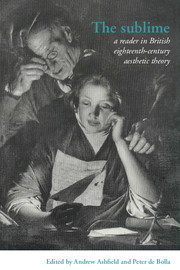Book contents
- Frontmatter
- Contents
- List of Abbreviations
- Introduction
- Part I The Longinian tradition
- Part II Rhapsody to rhetoric
- Part III Irish Perspectives
- Part IV The Aberdonian Enlightenment
- 28 An enquiry into the life and writings of Homer (1735)
- 29 Theodorus: a dialogue concerning the art of preaching (1752)
- 30 An essay on taste (1759)
- 31 An essay on original genius (1767)
- 32 Essays on the intellectual powers of man (1785)
- 33 Dissertations moral and critical (1783)
- Part V Edinburgh and Glasgow
- Part VI From the Picturesque to the Political
- Sources and further reading
33 - Dissertations moral and critical (1783)
Published online by Cambridge University Press: 05 June 2012
- Frontmatter
- Contents
- List of Abbreviations
- Introduction
- Part I The Longinian tradition
- Part II Rhapsody to rhetoric
- Part III Irish Perspectives
- Part IV The Aberdonian Enlightenment
- 28 An enquiry into the life and writings of Homer (1735)
- 29 Theodorus: a dialogue concerning the art of preaching (1752)
- 30 An essay on taste (1759)
- 31 An essay on original genius (1767)
- 32 Essays on the intellectual powers of man (1785)
- 33 Dissertations moral and critical (1783)
- Part V Edinburgh and Glasgow
- Part VI From the Picturesque to the Political
- Sources and further reading
Summary
Illustrations on sublimity
Longinus, the Secretary of Zenobia queen of Palmyra, who was conquered by the emperor Aurelian about the middle of the third century, composed many books of philosophy and criticism, and among others a discourse on Sublimity, which is the only part of his writings that has been preserved to our time. He is an author, not more remarkable for accuracy of judgment, than for the energy of his style, and a peculiar boldness and elevation of thought. And men of learning have vied with each other, in celebrating and expounding that work; which is indeed one of the best specimens that remain of ancient criticism, and well deserves the attention of every scholar.
But he has used the word hupsos in a more general sense, than is commonly annexed to the term sublimity; not always distinguishing what is sublime from what is elegant or beautiful. The distinction, however, ought to be made. Both indeed give delight; but the gratification we derive from the one is different from that which accompanies the other. It is pleasing to behold a fine face, or an apartment elegantly furnished and of exact proportion; it is also pleasing to contemplate a craggy mountain, a vast cathedral, or a magnificent palace: but surely, the one sort of pleasure differs as much from the other, as complacency differs from admiration, or the soft melody of a flute from the overpowering tones of a full organ.
- Type
- Chapter
- Information
- The SublimeA Reader in British Eighteenth-Century Aesthetic Theory, pp. 180 - 194Publisher: Cambridge University PressPrint publication year: 1996
- 2
- Cited by



